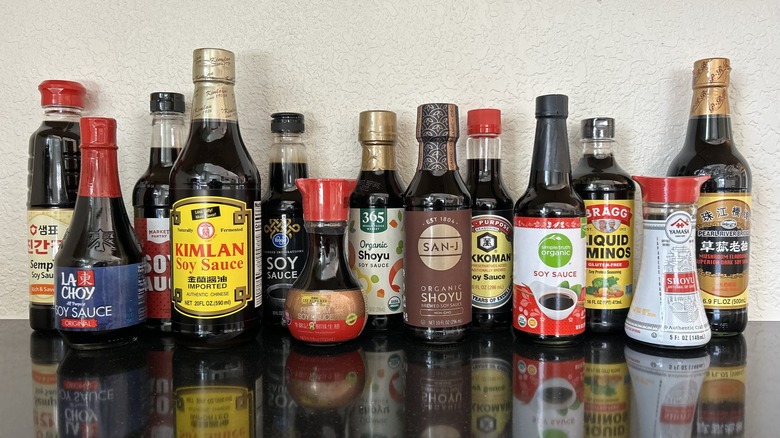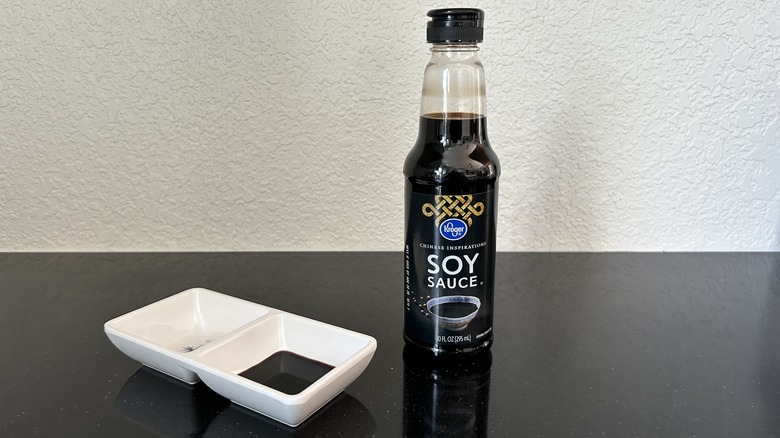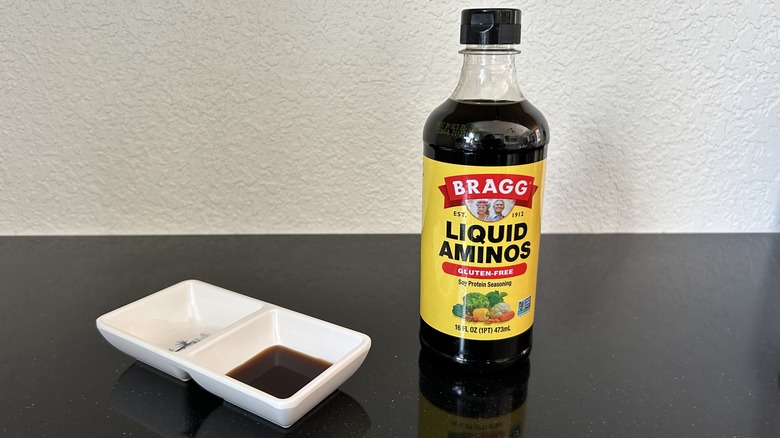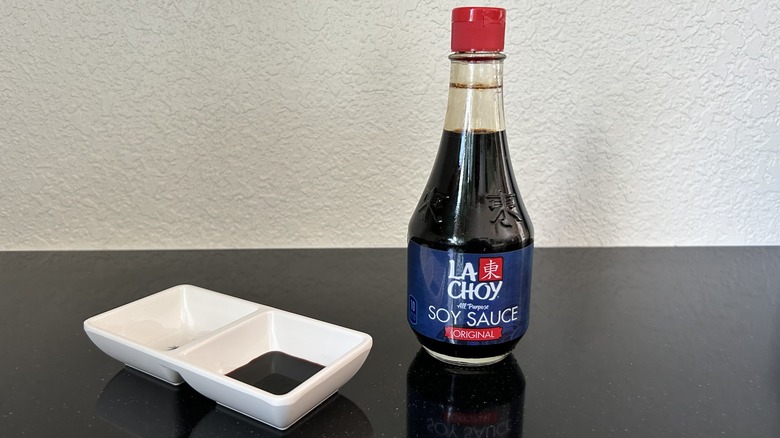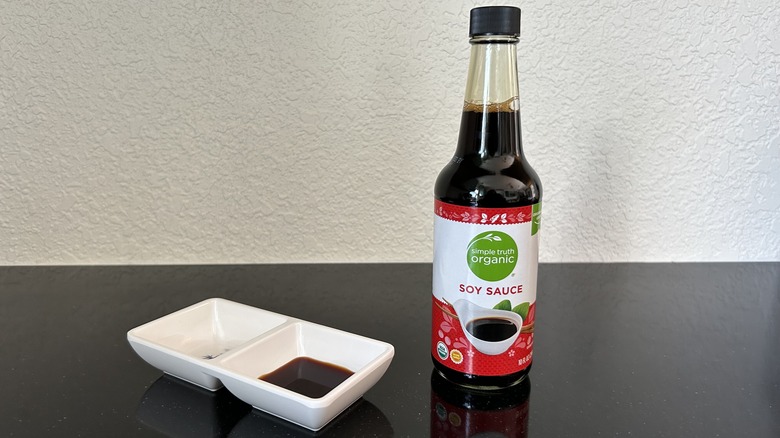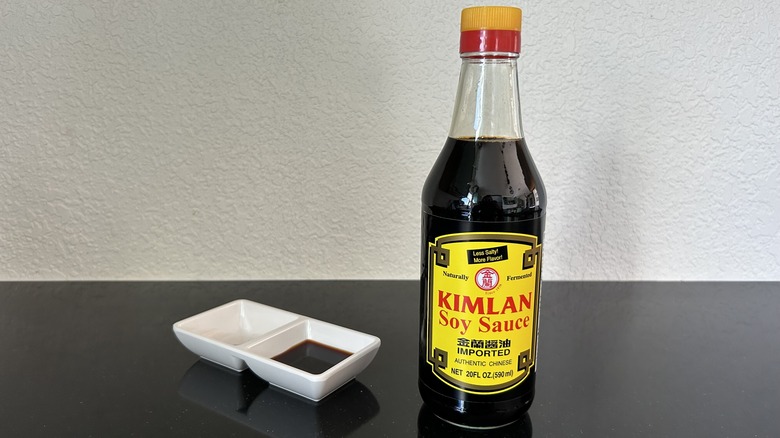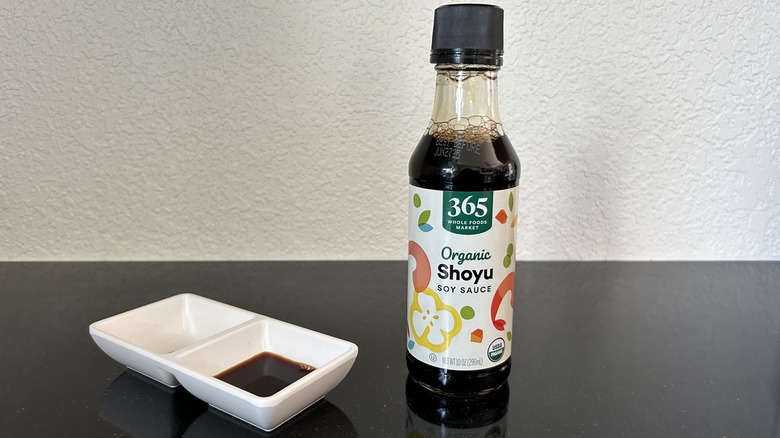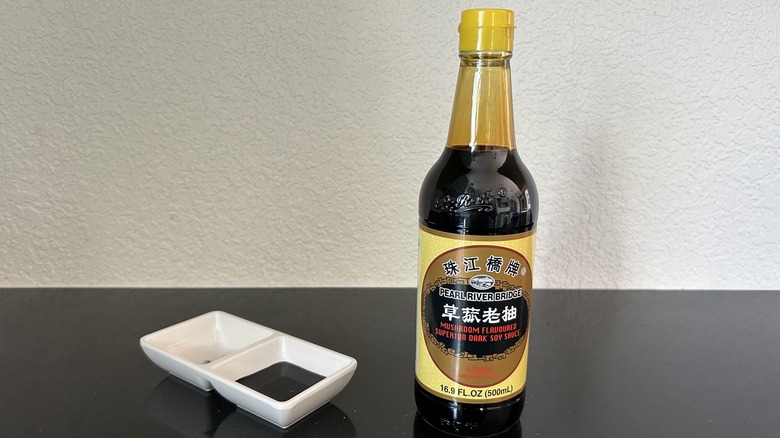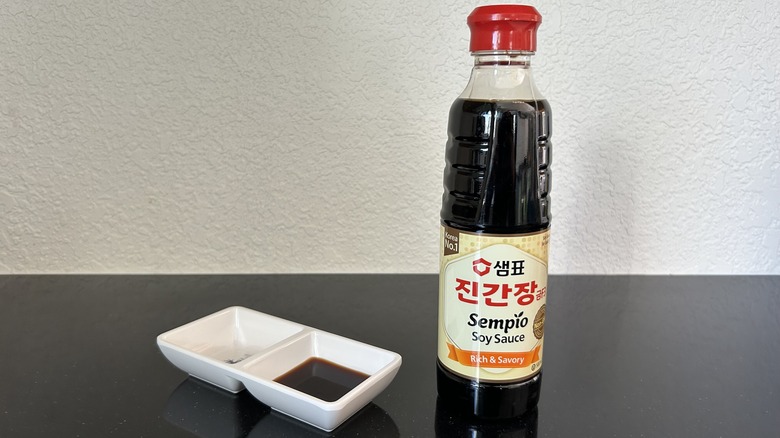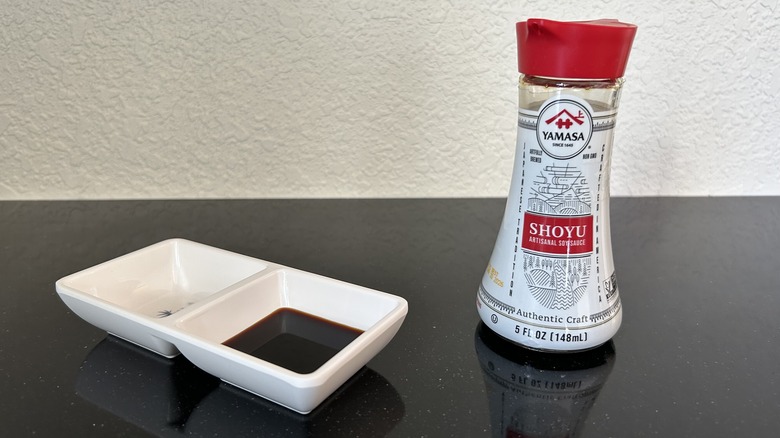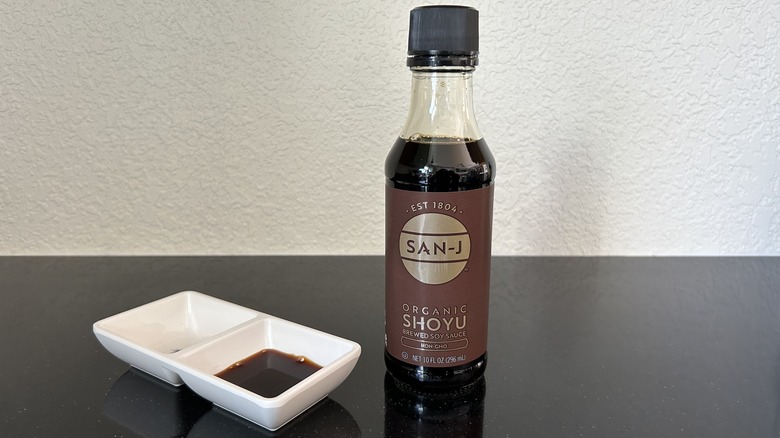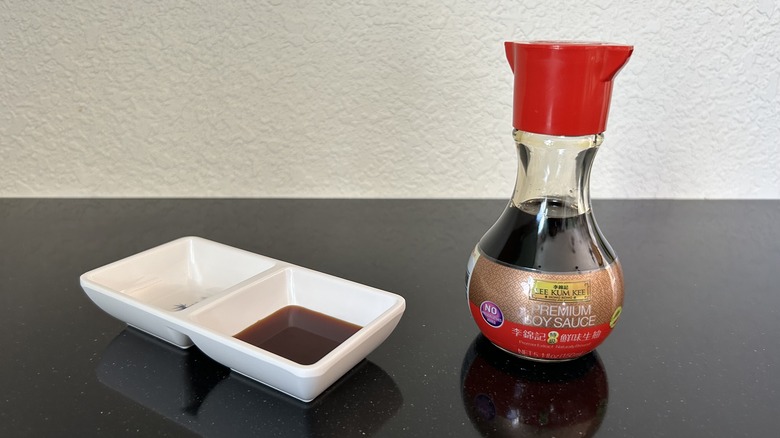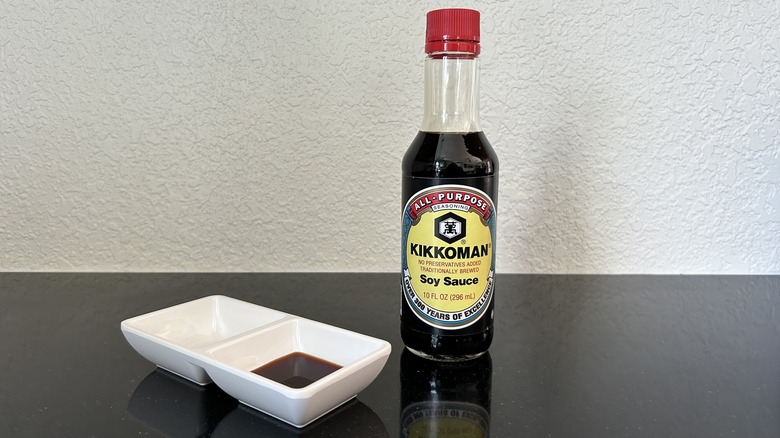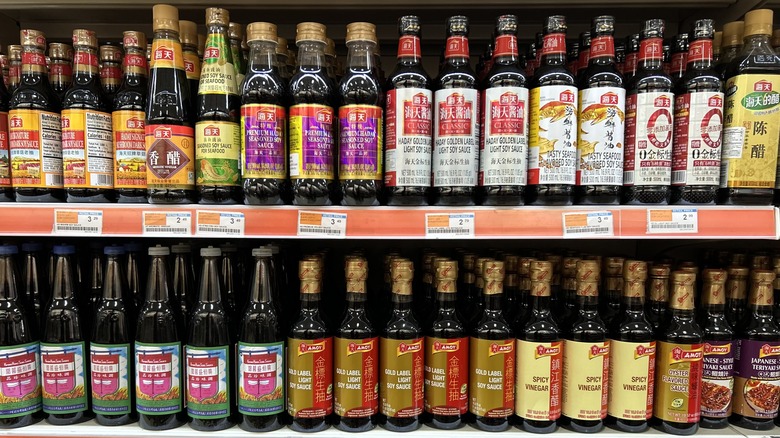13 Popular Soy Sauce Brands, Ranked Worst To Best
Soy sauce has been made for more than two millennia, and appears in the traditional cuisines of many Asian countries. Varying production techniques and uses of the ingredient inspired the creation of different types of soy sauces, from Chinese and Japanese styles to seasoned varieties to tamari and much more.
Alongside all of these flavorful options, there are numerous brands that manufacture soy sauce. Some have been in operation for hundreds of years, building upon generations of expertise. Others have opted for lab coats rather than chef coats, skipping the fermentation process and thereby creating what is, in my opinion, an inferior product. Yet these bottles all look quite similar on grocers' shelves.
Indeed, even among traditionally brewed soy sauces, not every brand is equal as far as quality, value, selection, and availability at easily accessible stores. With hours of research and meticulous taste testing, I've rounded up 13 of the most popular soy sauce brands, ranked worst to best.
13. Kroger
Kroger soy sauce ranks at the bottom of this roundup because tasting it was, frankly, a very unpleasant experience. So much so, that I found myself spitting out the product — and not for the reasons you might spit out wine at a wine tasting. This soy sauce was intensely salty, given its 1,340 milligrams of sodium per tablespoon. No other product I tested contains as much sodium, aside from the Pearl River Bridge dark soy sauce. However, light and dark soy sauces differ in their intended uses, making Pearl River Bridge's sodium quantity more justified. Kroger soy sauce, on the other hand, is seemingly using salt as a mask.
There are two primary ways to create soy sauce: through traditional brewing or chemical hydrolysis. Rather than the millennia-old practice of fermentation, the latter technique involves exposing soybeans to hydrochloric acid to speed up the process. To make it appear and taste more like traditionally produced soy sauce, coloring and flavorings are often added. Sometimes, chemical soy sauces are also blended with a naturally brewed version so that the resulting product is more palatable.
Unfortunately, Kroger soy sauce is, in my opinion, very much unpalatable. Along with an overpowering salt flavor, there's a chemical-like bitterness. Although it's affordable and accessible in Kroger stores, skip this one if you can.
12. Bragg
Some cultures may disagree that liquid aminos fall under the soy sauce umbrella. Still, many are drawn to the health-associated Bragg brand and opt for liquid aminos for a variety of reasons. However, I'm personally skeptical.
Traditionally brewed soy sauce is often mixed with wheat, whereas liquid aminos — which are made via the chemical hydrolysis process — are gluten-free. But the same gluten-free characteristic can be had with tamari, which is naturally made and, in my opinion, much closer to authentic soy sauce in flavor. To me, Bragg liquid aminos has an unfamiliar taste, and not in a particularly pleasant way. It has a watery consistency, yet is cloudy with a greenish hue. Its taste is savory, but not the same umami richness most would expect of a soy sauce. Rather, it had a flavor akin to jerky, leather, and tobacco, and lacked balance from sour or sweet notes.
Bragg boasts that its liquid aminos contain 16 amino acids, which are essential for proper health. But soy sauce can contain as many as 18 amino acids, making Bragg's brag a less compelling argument. All this said, it's harder to justify this product's higher-than-average price tag seen at stores like Whole Foods, Walmart, and supermarkets owned by Kroger.
11. La Choy
La Choy soy sauce is also made via a chemical process, evident in the fact that it contains hydrolyzed soy protein. I found its flavor profile to be more desirable than Kroger's, probably due to the inclusion of corn syrup. This sweetener likely helps to balance the pungent bitterness noticed in the Kroger soy sauce, but still, La Choy had a lingering chemical taste and was far too salty.
Of the products tested, the original La Choy soy sauce ranks third-highest in sodium quantity, totaling 1,330 milligrams per tablespoon. La Choy also offers a lite version which contains roughly half of the sodium. Both options are available in 10- and 15-ounce bottles, which are sold at many chain grocers including Kroger and Albertsons stores, Walmart, and Meijer.
Though it's easy to find on shelves, La Choy is lacking in selection compared to other brands. Its soy sauces are also evidence that good things take time. Those with gluten intolerances may be tempted to grab La Choy, as its soy sauces are gluten-free. But again, I'd instead pick up a bottle of tamari, which is naturally made and can be free of wheat products.
10. Simple Truth
Simple Truth is another brand by Kroger, sold exclusively at its owned stores which, in some parts of the country, are better known as Ralphs, Fred Meyer, Smith's, and King Soopers, among others. The brand offers USDA-certified organic soy sauce, with its selection limited to a traditionally brewed soy sauce and reduced sodium, gluten-free tamari. Both are a step above most budget options in regard to cost and quality.
I found the Simple Truth organic soy sauce to be medium in color and consistency — similar, though a bit murkier than household brand Kikkoman. But unfortunately, the two don't match up flavor-wise. While savory, salty, and acidic, the Simple Truth soy sauce is too sharp, lacking subtle sweetness and bitter notes to create a more rounded, complex taste. Overall, it's not a bad pick given its ease of access and mid-range price point. But the selection is limited, and in my opinion, there are tastier options that are equally convenient to find.
9. Kimlan
Kimlan is a large soy sauce manufacturer based in Taiwan that has been around since 1936. Its Chinese-style soy sauce is darker and deeper in flavor than Japanese-style shoyu — which many Americans are familiar with, given the prevalence of Japanese brands such as Kikkoman.
Still, Chinese-style soy sauces vary immensely. I found Kimlan's naturally brewed soy sauce to be bold with a nice savory quality, but it tasted more acidic than any other brand I sampled. It also has a more pronounced alcohol aroma, and I wish its bottle had a slow-pour function like the other products I tested. Additionally, while Kimlan may appear on the shelves of international supermarkets, you're less likely to find it in big-name grocery stores.
It's worth noting that while I found Kimlan's sourness to be a bit off-putting, I only tasted the product on its own. Applied in Taiwanese recipes, its flavor nuances may be much more desirable.
8. Market Pantry
Market Pantry is one of Target's in-store grocery brands, and if you're surprised to see it rank in the top 10 of this review, you're not the only one. I wouldn't have guessed its soy sauce to be as honestly decent as it is, especially given that it's priced under $2 for a 15-ounce bottle.
Unlike other budget options, Market Pantry soy sauce is traditionally brewed. Compared to well-known brands like Kikkoman and Yamasa, it's a touch heavier on the salt with 1,050 milligrams of sodium per tablespoon. But still, that quantity is significantly less than similarly priced competitors. That said, I still found the Market Pantry soy sauce to have a dominating salt flavor, and wish it were more rounded. The selection is also limited to just the original and a reduced-sodium version. But still, Market Pantry wins points for accessibility, and in my opinion, its value is outstanding.
7. 365
The Whole Foods in-house 365 brand offers two versions of its Japanese-style soy sauce: a regular shoyu and reduced-sodium option. Both are traditionally brewed, USDA-certified organic, and available in 10-ounce bottles. A 20-ounce option is also available for the traditional soy sauce, and it's worth buying this in bulk to increase value — overall, 365 makes a solid product.
This soy sauce is packaged with a slow-pour insert to make every drop count. It's darker in color and well-rounded in flavor. Compared to other Japanese brands tested, 365 has a less bold, umami-rich quality. But its more mild taste and aroma allow it to adapt well in a variety of flavors and dishes.
Meanwhile, 365's reduced-sodium version takes cues from brands like Yamasa, with water, distilled white vinegar, and lactic acid tempering the saltiness of soy sauce — while still maintaining flavor. Though water dilutes the solution, vinegar and lactic acid ensure soy sauce's natural sour notes aren't lost, and the taste remains full and balanced.
Though these are quality products, the selection is very limited compared to other brands. Additionally, while Whole Foods has hundreds of locations, stores are lacking in many parts of the United States, and 365 isn't carried at other grocers. However, like many products featured on this list, you can purchase 365 via Amazon.
6. Pearl River Bridge
Founded in 1958, Pearl River Bridge distributes Chinese-style soy sauces in options including organic, reduced sodium, light, dark, and seasoned varieties. Though it touches on several categories, the selection is curated into eight distinct products that are available at select Asian grocers.
During a trip to H Mart, I found several Pearl River Bridge options, but I was especially drawn to its mushroom soy sauce — an underrated umami bomb. This dark soy sauce has a concentrated mushroom aroma, thick consistency, and is nearly black, which will give a beautiful brown color to any dish it's added to. Use it to make stir-fry or fried rice, or even in a marinade to create flavorful proteins.
Given its pungent taste, I wouldn't recommend this soy sauce for poke bowls, dipping, or for use in delicate dishes. However, Pearl River Bridge has other traditionally brewed options for those purposes, all at a mid-tier price.
5. Sempio
Established in 1946, Sempio is the oldest soy sauce brand in Korea. Today, the company creates an assortment of products including gochujang, noodles, and side dishes like kimchi. Similarly, its soy sauce selection has grown into more than a dozen distinct options. Popular choices include its naturally brewed soy sauce 501 and 701.
Along with these traditional options, Sempio makes reduced sodium, organic, and flavored varieties. Not seasoning your soy sauce is a total waste of a delicious opportunity, but many of Sempio's products have already taken care of that step for you. For example, its Jin Gold F3 soy sauce features licorice extract and a bold, umami-rich flavor. There's almost a meaty quality to it, along with an incredible, mouthwatering aroma.
What's especially unique about Sempio is that it creates dish-specific soy sauces. These include its soy sauce for soup and varieties made specifically for sushi, stir-frying, and more. Each is blended with complementary ingredients, like katsuobushi extract in its soy sauce made for egg dishes, and ginger in its version made for dumplings.
While Sempio's versatility and value are hard to beat, the brand is unfortunately lacking in accessibility, at least in the United States. You'll likely have to visit an Asian grocer or shop online for this one, but the effort will be worthwhile.
4. Yamasa
Founded in 1645, Yamasa is one of Japan's oldest soy sauce brands. In 1992 the brand set up shop in the U.S., and two years later began brewing shoyu at its plant in Oregon's Willamette Valley. Since then, the brand acquired big-name soy sauce manufacturer San-J, and has expanded its product options to include ramen broths.
As for its soy sauce, Yamasa offers one organic, gluten-free tamari and two styles of artisanal shoyu. Its standard shoyu is dark in color with an umami-rich quality, as most would expect of a quality soy sauce. Subtle notes of acid, sweetness, and even a mild bitterness add complexity, and result in a rounded, delicious flavor. Yamasa also creates a reduced sodium version made with vinegar and lactic acid, which maintains traditional soy sauce's sour qualities.
Compared to certain brands, Yamasa is less accessible, but it's carried at chains like Whole Foods and Albertsons. Many Asian grocers like H-Mart also stock Yamasa soy sauce, and often in bulk quantities. Overall, Yamasa scores highly across the board given the quality, versatility, and value of its products — but admittedly, its soy sauce selection is small. However, each option adapts well to a range of dishes and is made with expertise.
3. San-J
The Sato family founded San-J in 1804, a testament to the enduring quality of this naturally brewed soy sauce. First established in Japan, the brand now operates out of its Virginia-based plant, where soybeans are fermented for as long as six months. San-J is largely known for its tamari options, including organic, low-sodium, and flavored versions, all of which provide a range of uses.
Tamari is different from soy sauce, as it's generally made from crushed soybeans without wheat — and is thereby gluten-free. On the other hand, Japanese-style soy sauce, known as shoyu, is often a combination of soybeans, wheat, koji, salt, and water.
Unsurprisingly, these differences in ingredients create distinctions in flavor. San-J tamari features a darker color and smoother, less salty profile. The brand also creates one traditional soy sauce: an organic shoyu with a well-rounded flavor that's richer and bolder compared to the other Japanese products tested.
In addition to a wide selection, San-J is readily available at many American grocers, including Kroger and Albertsons stores, Whole Foods, Target, and Walmart. Pricing varies, but overall, San-J falls in the mid-tier range. When it comes to value, quality, versatility, and convenience, San-J checks all of the boxes. However, there's an opportunity to grow its traditional soy sauce selection. The bottle size is also limited to 10 ounces, and a bulk option would be nice.
2. Lee Kum Kee
Lee Kum Kee was launched in 1888 following the accidental invention of oyster sauce by its founder, Lee Kum Sheung. Today, the brand offers more than 300 sauces and condiments, including 33 varieties of Chinese-style soy sauce. The vast selection features reduced sodium and gluten-free options, as well as several seasoned varieties, some of which are tailored to specific uses like cooking and dipping. There are also higher-end options, like its "first draw" and double-fermented soy sauces.
I sampled Lee Kum Kee's premium soy sauce, which is available in a variety of quantities — including a 5.1-ounce soy sauce bottle with two spouts. But in my opinion, this charming design element is just one of many reasons to love this product. It has a rich umami quality and a punch of salt that's perfectly balanced with other flavors.
Similarly to Kimlan, Lee Kum Kee premium soy sauce has a pronounced acidity, but it's balanced with delicious hints of citrus and even floral notes. Most Lee Kum Kee products are priced in the mid-tier range, making them an exceptional value, and are available at select Kroger and Albertsons stores, as well as many Asian grocers like H Mart.
1. Kikkoman
Kikkoman dates back to 1917, following the merger of eight family companies, the oldest of which was established as early as 1603. Centuries of expert techniques were combined with large-scale manufacturing, resulting in what's now an empire in the global food industry. In the United States, you'll find Kikkoman soy sauces at national chains owned by Kroger, as well as Whole Foods, Target, Walgreens, and more. Of course, Kikkoman is also stocked at Asian grocers.
The brand covers a range of preferences, from its original traditionally brewed soy sauce to reduced sodium, organic, gluten-free, and premium double-fermented versions. It also offers tamari and has dish-specific varieties, with one sweet soy sauce ideal for rice and another for sushi and sashimi. Despite the range, Kikkoman doesn't overwhelm consumers, keeping the selection to a dozen options.
Its classic soy sauce is savory, salty, acidic, and slightly sweet with a pleasant aroma. It's a winner for both dipping and cooking, as its balance will complement — not overpower — any recipe. Overall, Kikkoman offers versatility, accessibility, value, and a range of options that will please every palate.
Methodology
To create this guide, I first checked what was available at my local grocery stores. I'm based in the Denver area, and popular grocers with decent soy sauce selections include Whole Foods, Target, and King Soopers, which is a Kroger-owned store. Given soy sauce's origin and prevalence in Asian cuisines, I also felt it was important to visit an Asian market. I opted for H Mart given that it's the largest Asian grocery chain in the United States and therefore, the international brands featured will hopefully be accessible to readers.
To determine what was most popular, I took note of brands that appeared at several of the region's retailers and researched brands' distribution online. After purchasing these products, I taste-tested them back-to-back to pick up on even subtle differences in flavor. Aroma and color were also observed, as was product packaging. The quality of these aspects was then compared with prices to determine value.
Finally, I researched each brand's history and selection of soy sauces, and also considered versatility to make final judgment calls. While some of these qualifiers are straightforward, taste is obviously subjective. Additionally, given the cultural association with soy sauce, it's important to note that this ranking does not take into account individuals' personal sentiments towards these products. However, everyone can agree that our pantries — or, if your soy sauce doesn't have sodium benzoate, fridges — are better with soy sauce.
